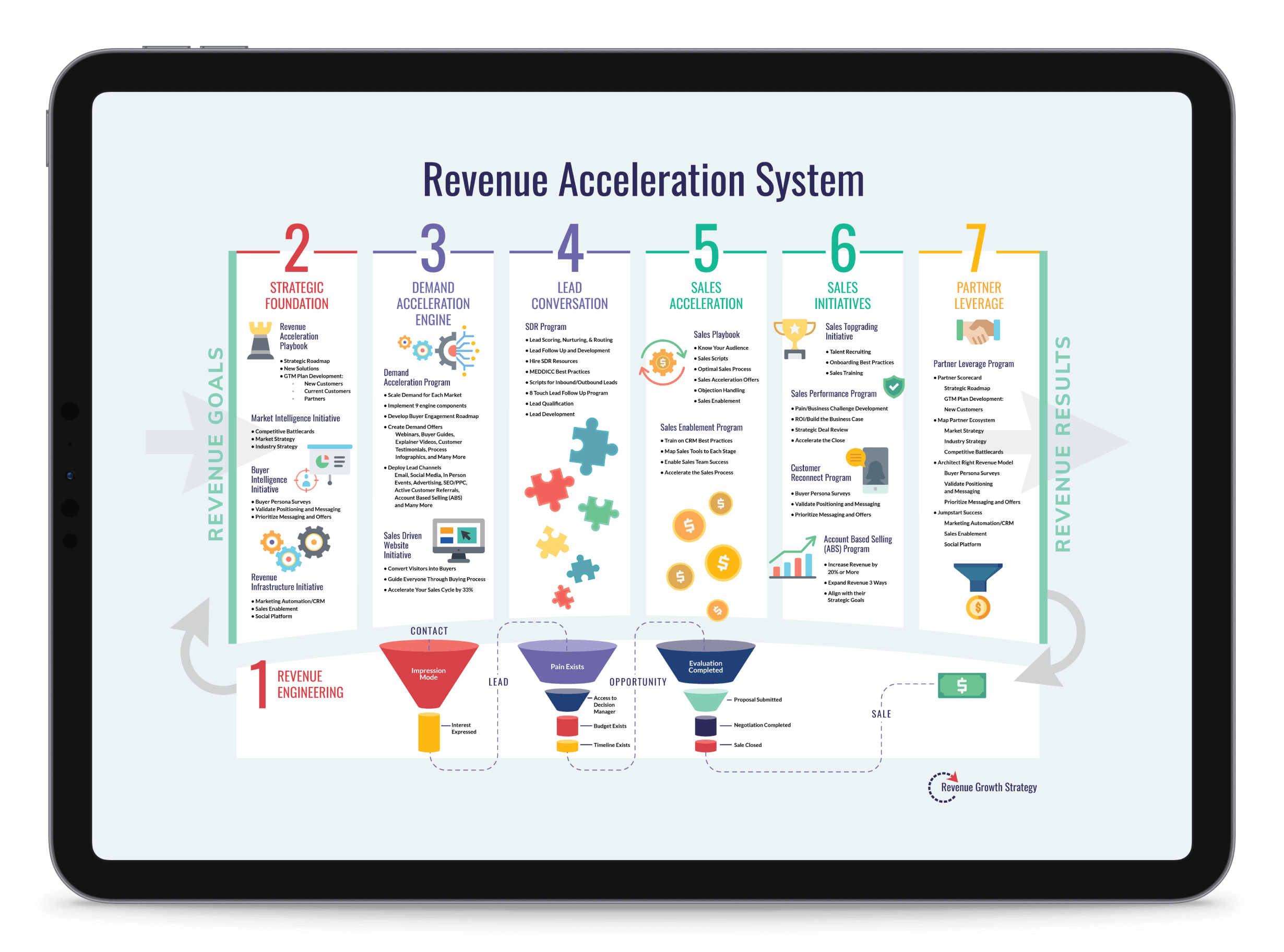Every B2B Executive has the same pressing request “I need more leads and better quality leads”. Now starts the endless experimentation in programs and campaigns to generate demand for their company. Many of these programs or campaigns either do not work or are not sustainable.
There is a better way to create predictable, consistent and scalable demand for your solutions and services. You need to implement a Demand Generation Engine. So why do I use the “Engine” metaphor?
Achieve predictable revenue growth of 25% or more in your B2B business this year
Get my detailed infographic to see how you can follow my unique framework to scale your business, step-by-step. Click below to download the Ultimate Revenue Acceleration Guide.
When you have an Engine, you can scale and go farther. When you have an Engine, you can press the pedal and go faster – accelerate. Finally, when you have an Engine, you realize that all of the components needs to work flawlessly together. What I have discovered is that there are 9 components that need to be implemented to put your Demand Generation Engine in place. Let’s walk through each of the components and why they are necessary.
1. Create Your Intentional Revenue Engineering Model
To begin with we need to understand where we are going. Is the objective to increase revenue by 30% year or year? If so, we need to understand our conversation rates and determine how many market qualified leads (first funnel), sales qualified leads (second funnel) and customer transactions (third funnel) will be required per month to achieve this growth goal. I call this revenue engineering, and you can create these three funnels for every target market, industry, customer base, partner channel, and new solution or services. It is eye opening to understand the prescriptive mathematical model that needs to be put in place to engineer the outcomes you need.
2. Migrate to Outcome Focused Messaging

What is the most immediate way to connect with decision makers? Focus on the outcomes that they need.
Often a company’s messaging is focused on their services or solution. Instead, let’s understand your buyer and what is their challenge and solution options. Now you are engaged to help them address and solve their business challenges. The next step is to help your buyer optimize a critical business process such as lead to cash or concept to delivery. Every company needs help to create, implement and optimize key business processes that help them thrive. The next step is to focus on outcomes. All C-Level executives need to deliver specific outcomes for their company such as increased sales, customer retention or on time delivery. When your messaging focuses on how you can help you buyer deliver outcomes you significantly improve your engagement with your buyer
3. Validate with Buyer Intelligence
Once you create the most compelling and potent messaging for your solution and services, it is necessary to validate it with you key decision makers. Often we do not know what messaging, positioning and offers will be most important to you audience until you validate it. A Buyer Intelligence Survey can help you to statistically determine the messaging and positioning that is most important and prioritized by you target decision makers.
We have help conduct hundreds of these buyer intelligence surveys to eliminate the guesswork so that you lead with the right messaging and positioning with you demand generation campaigns, on your website and in your sales conversations
4. Reach 100% of Your Target Market
After conducting executive workshops with CEOs across North America, I have asked what percentage of your target audience are you reaching today. It is not unusual for them to respond 5-10%. As part of your Demand Generation initiative, you need a systematic way to reach 100% of your target audience – if not today – over time.
Every year 5-10% of your target audience will consider your type of service or solution. They will not become your customer if they do not know that you exist. That is why you need to reach and engage every target decision maker so that they have a chance to be your customer.
For the past several years we have been a partner of ZoomInfo or Apollo.io to help our clients scale the audience that they reach. In some situations the audience is truly unique so we will build the target audience database from scratch to create a truly unique approach for our clients. The most important takeaway here is to implement a reach strategy to engage 100% of your target audience.
5. Implement Your Revenue Acceleration Infrastructure
Every company needs three revenue acceleration systems. The first is your Marketing Automation system so that you can launch, track and prioritize the effectiveness of your Marketing campaigns and programs. You need “one source of truth” and you need to be able to discern where to invest and where not to invest based on your metrics.
The second system you need is a CRM system to track and manage all of your leads and opportunities. A well-orchestrated sales process will help you convert sales opportunities into customers. There are a number of options here for you MA/CRM solution including Salesforce, HubSpot and others so you want to make the right choice and implement with best practices that I have created from many implementations.
Finally, you need a way to organize your content and sales tools for your sales team and partners. I created a sales enablement solution called OneSource. If you do not organize your sales tools to align with your sales process it will make it difficult if not impossible to get new sales executives productive quickly. Further, you invest in Marketing to create compelling tools and offers and they will not be used – many go to the marketing graveyard – if not reinforced through the daily use by your sales team.
6. Map Your Buyer’s Journey
How does you buyer want to get educated about your service or solution, evaluate it, and begin to use and benefit from it. Take your best consultative sales person and think through the collaborate steps that each buyer wants to take in their journey. You can map the buyer’s journey for each buyer – based on many criteria including industry or market segment, persona, solution or other buyer relevant criteria.
Once you may map the buyer’s journey, you understand how you can enable this frictionless process and deliver the scripts, tools and offers that will complement each step of the journey and accelerate the process.
7. Engage Your Buyer with the Right Offers
At each stage of the buying process, you will need compelling offers to engage your target audience. At the awareness stage, you may need to offer a thought leadership or best practices webinar or guide. You will also need to provide an overview guide for you solution. At every stage you will engage with specific offers to help progress your buyer on their journey. Here is an example of a buyer’s journey for one of my clients.

8. Engage Your Buyer with the Right Channels
When you engage your audience there are many channels available to you. You want to leverage a multi-touch approach and select the right channels for your audience. Every company will need an email campaign strategy, a social media strategy and an in person or event strategy. Beyond these initial three channels there are plenty of other channels that can be explored so that you have a rich mix of channels to reach your audience. Other channels could include content syndication, search engine optimization (SEO), pay per click placement (PPC) and paid ads.
9. Measure Your Conversions and ROI
Finally, every campaign has a conversion rate, cost per conversion and campaign effectiveness rating. Each quarter, you can assess the effectiveness of each campaign to determine how to modify for better results. Each quarter, you can compare each campaign against other campaigns to select where to invest based on success and where to divest based on failure.
For instance, you may invest in events that are very expensive to attend or present but may have a low conversion rate into sales opportunities. If you only attend events and send email campaigns, it is difficult to determine where to get a better ROI. I good mix that is evaluated and adjusted every quarter will keep you on the path to the optimal ROI.
From this blog you can see that a tremendous level of experience and serial best practices have been developed to deliver your demand generation engine. If you value what I have shared in this blog, download my Revenue Acceleration System here, which includes a detailed infographic to see how you can follow my unique framework to scale your business, step-by-step.



